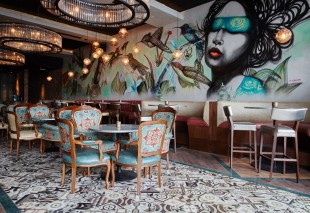

Outlet 360: Aji

Front of house
Fusing Japanese and Peruvian cuisines, Retail & Beyond’s Ají opened last year at Club Vista Mare on Palm Jumeirah. Keane’s Dubai office was appointed to craft the Nikkei-style restaurant’s space with a brief to reflect the countries without obvious references.
Retail & Beyond’s vice chairperson Yana Kalwani explains: “We see a seamless blend of old meets new; two cultures intertwined — which is what our food is about. We also have a mix of furniture that allows for a casual, relaxed feel, while still maintaining the upscale look of the place.”
Keane regional director Helen El Mettouri says the references to both cultures are seen through subtle hints, mainly through textures and patterns: “This scheme is very eclectic with a blend of quite traditional patterns, textures and worn-in finishes.”
Alongside the terrace with external bar, the 940m2 venue comprises a bar and lounge, main dining area with ceviche, sushi and tiradito counter and a private dining room. Features include a colourful mural in the bar portraying a Peruvian woman and a similar mural in the main dining area. Both were painted by local artist Rami Elzaguawy. “We wanted to tie the graphic elements into an overall scheme, and his murals were the last finishing pieces added. As the installation was growing over the wall, you could see people walking by and curiously looking at it, so it became a talking point before we even opened the venue,” says Keane head of projects John Rowley.
Most of the low-seating furniture was custom-made in the UK. “The upholstery has the feel of being worn and reclaimed, but it isn’t,” says El Mettouri, adding that the team used “different levels of textures, such as metallic leathers and heavily patterned upholstery”. The lounge, connecting the bar and main restaurant, has custom-made plaster panels that fit into the Aztec design and help separate the areas. A DJ booth is alongside another bar counter for mixologists, creating a more secluded setting.
Rowley adds: “It’s about creating different points of view all the time. Whether you are seating in the main or the private dining area, we wanted to ensure there are no dead corners and there is always some activity going on.”
The designers wanted to achieve a “nothing is too perfect” effect. Rowley comments: “Dubai can feel too polished sometimes. That’s why we used a lot of antique brass and handcrafted flooring. Each one of these tiles is hand-made, and some of them may have a defect, but that is what gives a character to space.”
Back of house
With Nikkei working by transforming Peruvian dishes using Japanese flavours and techniques, Ají benefits from a head chef who has been a pioneer of the concept for more than 12 years — Peruvian-raised head chef Erick F H Oshiro.
His signature dishes include Ají tiradito especial and Ají Ceviche, created at the open plan sushi, ceviche and tiradito counter in view of diners.
Other dishes on the menu include: beef ishiyaki, served raw with a hot stone to create an element of theatre at the table; Angus short ribs, slow-braised with tonkatsu, star anise and membrillo for 24 hours; beef sirloin with Ají amarillo and caramelised onions; soft shell crab causa with escabechado sauce, coriander and botija olives; and beef skewers with anticuchera sauce and shansho butter.
Unlike the sushi, ceviche and tiradito counter, Ají’s kitchen is closed. “An open-plan kitchen is only worthwhile if there is something worth seeing.
“Here we are only showing what we want you to see. The rest of the cooking is done behind the closed doors, guests don’t need to see everything,” points out El Mettouri.
On the beverage side, there are several sakes available and cocktails with a twist — that come with names like matcha ceremony, piña ramen and kakigori. Asked how popular are Nikkei-style dishes and drinks proving to be with the Dubai crowd, Kalwani tells Caterer Middle East: “In recent months, there has been far more awareness of Nikkei cuisine in the region. Ají is one of the few restaurants that is dedicated to Nikkei food, however, other Peruvian restaurants have started introducing a few Japanese elements in some of their dishes. Having said that, we have customers almost every day, who have never tried this cuisine before.”
According to Kalwani, Ají being on the trunk of The Palm has helped to ensure that the new restaurant captures a wider market “without making guests feel too threatened by the distance on to The Palm”.
“Our customers are stunned by the interiors. In the beginning, many used to feel slightly intimidated by such a grand setting on the shore side, but they’ve come to realise that despite the many fancy features, the restaurant still allows for a friendly, relaxed atmosphere,” Kalwani comments, adding that the beach-facing element was an added draw in choosing this location.
Ají’s outdoor area is shared with six other restaurants, therefore the designers were fairly restricted regarding what could be done but they marked the area with planters and furniture, incorporating the upholstery with a traditional Peruvian feel to it.
In terms of the future of the concept, Kalwani says there are no plans for regional expansion but that Retail & Beyond is “open to opportunities in the international market”.